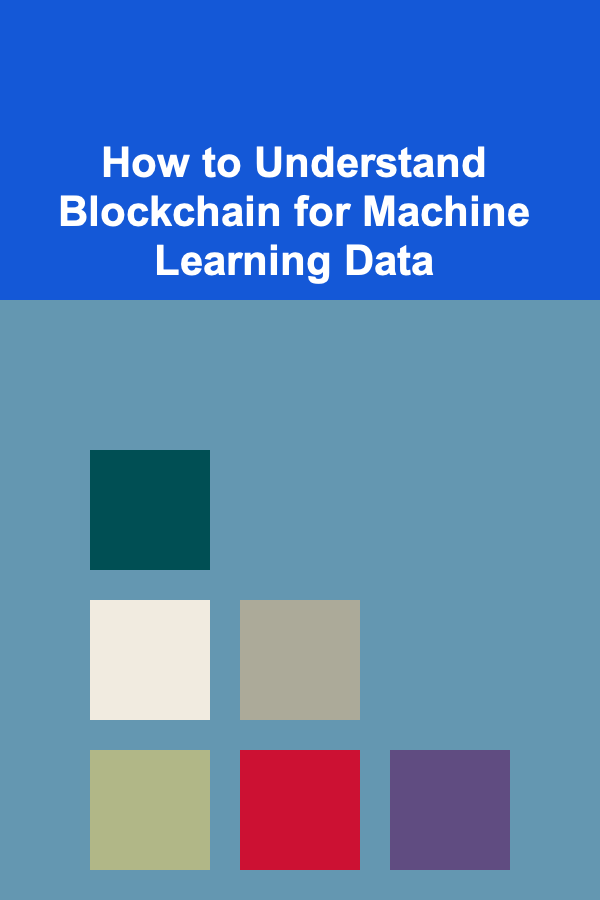
How to Understand Blockchain for Machine Learning Data
ebook include PDF & Audio bundle (Micro Guide)
$12.99$10.99
Limited Time Offer! Order within the next:

Blockchain technology, originally created as the underlying framework for Bitcoin, has rapidly grown beyond its initial use case to provide innovative solutions across many industries. One of the most promising areas of exploration is its integration with machine learning (ML). As both fields evolve, they stand to benefit significantly from one another. Blockchain can serve as a decentralized, transparent, and secure platform for managing and processing the large volumes of data required by machine learning models. Understanding the intersection between blockchain and machine learning data is essential for unlocking new capabilities and efficiencies in data management, data sharing, and model deployment.
In this article, we will delve into how blockchain technology can be applied to machine learning data, explore the benefits of integrating blockchain with machine learning, and outline the key concepts, challenges, and potential solutions. By the end, you'll gain a comprehensive understanding of this interdisciplinary relationship and how it can impact the future of AI-driven innovations.
1. Understanding Blockchain Technology
Before diving into how blockchain can be used for machine learning data, it is crucial to first understand the core principles of blockchain.
1.1 What is Blockchain?
At its core, a blockchain is a distributed ledger technology (DLT) that allows data to be stored across multiple locations in a decentralized and secure manner. Each record, called a block, contains a list of transactions, and these blocks are linked together in a chain, forming a transparent and immutable record of all activities. Key features of blockchain include:
- Decentralization: Unlike traditional databases controlled by a central authority, a blockchain is maintained by a distributed network of nodes (computers). This decentralization reduces single points of failure and increases security.
- Immutability: Once data is recorded in a blockchain, it is practically impossible to alter. This is due to the cryptographic nature of the system, which makes changing any data without detection extremely difficult.
- Transparency: All participants in the network can view and verify the data stored on the blockchain, ensuring that the system is open and transparent.
- Consensus Mechanisms: Blockchain networks typically use consensus protocols like Proof of Work (PoW) or Proof of Stake (PoS) to ensure that all participants agree on the state of the ledger.
1.2 Key Blockchain Components
To understand how blockchain interacts with machine learning data, it is important to understand the key components of a blockchain network:
- Blocks: The individual data units that store transactions or data records. Each block contains a cryptographic hash of the previous block, a timestamp, and transaction details.
- Nodes: These are the individual computers or entities that participate in the blockchain network. Each node has a copy of the blockchain, and they all work together to validate transactions and maintain the integrity of the ledger.
- Smart Contracts: Self-executing contracts that automatically execute, control, or document actions in a blockchain system. They can be used to automate processes in the context of machine learning, such as triggering model training or validating data quality.
- Cryptographic Hash Functions: These ensure that data is secure and immutable. Every block in the blockchain contains a cryptographic hash of the previous block, which ensures that once data is recorded, it cannot be changed without altering the entire chain.
1.3 Types of Blockchains
There are different types of blockchain networks, each with different use cases and levels of decentralization:
- Public Blockchain: Open to anyone, where anyone can participate in the network. Examples include Bitcoin and Ethereum.
- Private Blockchain: A restricted blockchain, usually used by enterprises for private, internal applications. Access is granted only to certain participants.
- Consortium Blockchain: A semi-decentralized model where a group of pre-selected entities control the network. This type of blockchain is often used in enterprise settings where multiple organizations collaborate.
2. Machine Learning and Data
Machine learning relies heavily on large volumes of high-quality data. Data is the lifeblood of any ML system, as models are trained and tested on data to learn patterns, make predictions, and drive decision-making processes. Understanding how data is managed, accessed, and protected in the context of ML is essential for appreciating the potential of blockchain.
2.1 The Role of Data in Machine Learning
In machine learning, data can be categorized into:
- Training Data: This is the data used to train machine learning models. The quality and quantity of the training data play a significant role in determining the accuracy and robustness of the model.
- Test Data: After a model is trained, it is tested using a separate set of data to evaluate how well it generalizes to unseen examples.
- Validation Data: Used to tune the model's hyperparameters and optimize its performance during training.
Machine learning typically requires large datasets, which are expensive and time-consuming to collect. Furthermore, these datasets often need to be shared across various entities and stakeholders, which introduces the risk of data privacy breaches and issues related to data ownership.
2.2 Challenges in Machine Learning Data Management
Machine learning faces several data-related challenges, including:
- Data Privacy and Security: Sensitive data, such as personal information, must be protected. Traditional centralized systems can be vulnerable to data breaches, and maintaining data privacy across multiple parties can be challenging.
- Data Provenance: Knowing where data comes from and ensuring its integrity is crucial. If the data has been tampered with or is of low quality, the model's predictions will be unreliable.
- Data Ownership: Multiple parties may be involved in generating, collecting, or using the data, leading to questions about who owns the data and how it can be shared securely.
- Data Sharing and Collaboration: Collaborating on data-driven research or building joint machine learning models requires sharing data between entities. This raises concerns over how to do so safely and transparently.
3. Blockchain as a Solution for Machine Learning Data
Blockchain technology can solve many of the challenges faced by machine learning in data management, sharing, and security.
3.1 Ensuring Data Integrity
One of the primary advantages of using blockchain for machine learning data is its ability to ensure data integrity. Blockchain's immutability feature ensures that once data is recorded on the blockchain, it cannot be altered. This is crucial for machine learning applications, where data integrity is essential for the accuracy and reliability of the models. Blockchain can provide a transparent audit trail of all changes to the data, making it easier to track data provenance and identify any tampering.
3.2 Enhancing Data Privacy and Security
Blockchain can provide a secure platform for sharing sensitive data without compromising privacy. Through the use of cryptographic techniques, such as zero-knowledge proofs (ZKPs), sensitive data can be shared without exposing the data itself. ZKPs allow one party to prove that they know something (e.g., a data record) without revealing the actual content.
Furthermore, blockchain's decentralized nature reduces the risk of a single point of failure, making it harder for attackers to compromise the entire system. This makes blockchain an attractive solution for industries such as healthcare, finance, and any other field where data privacy is critical.
3.3 Facilitating Data Sharing and Collaboration
Blockchain can facilitate secure and transparent data sharing between different organizations, researchers, or stakeholders. Instead of relying on centralized systems, where data might be siloed and subject to different access controls, blockchain allows multiple parties to collaborate on shared datasets with built-in trust and accountability.
Smart contracts can automate data-sharing agreements, triggering actions such as data validation or model training once certain conditions are met. These contracts could define terms like data access rights, usage restrictions, and ownership, ensuring compliance with privacy regulations such as GDPR.
3.4 Data Provenance and Traceability
Blockchain can provide a transparent and immutable ledger of data provenance, ensuring that the origins of data are easily traceable. This is particularly important in machine learning, where data quality and source can significantly affect model performance. With blockchain, it becomes possible to track the history of data, including its acquisition, transformations, and usage, helping ensure that the data is legitimate and unaltered.
4. Real-World Applications of Blockchain for Machine Learning
Several industries are already exploring the use of blockchain to improve machine learning data management, sharing, and security. Some examples include:
4.1 Healthcare
In the healthcare industry, where patient data is highly sensitive, blockchain can be used to manage medical records in a secure, transparent, and decentralized manner. Blockchain can ensure that medical data is tamper-proof and shareable only with authorized parties. Machine learning models can then be trained on this data to make predictions or improve diagnostics without compromising patient privacy.
4.2 Financial Services
In the financial industry, blockchain can be used to securely share financial data across different entities, such as banks, insurers, and regulatory bodies. By integrating blockchain with machine learning, financial institutions can build more accurate predictive models while ensuring compliance with regulations like Know Your Customer (KYC) and Anti-Money Laundering (AML).
4.3 Autonomous Vehicles
In the autonomous vehicle industry, blockchain can be used to securely share data from different vehicles or sensors, enabling more accurate training of machine learning models. This can help improve the performance of self-driving algorithms by providing a more extensive and diverse dataset while ensuring data privacy and security.
4.4 Supply Chain Management
Blockchain can be applied to supply chain management by providing a transparent and secure ledger of data related to the movement and transformation of goods. Machine learning models can be trained on this data to predict trends, optimize inventory, or detect fraudulent activities.
5. Challenges and Future Directions
Despite its potential, integrating blockchain with machine learning is not without challenges. Some of the hurdles include:
- Scalability: Blockchain networks, especially public blockchains, can face issues with scalability, particularly when it comes to processing large volumes of data needed for machine learning.
- Interoperability: Different blockchain platforms and machine learning tools may not be easily compatible, creating challenges for integration and standardization.
- Computational Efficiency: Blockchain's consensus mechanisms, such as Proof of Work, can be computationally intensive, and integrating them with machine learning models may add unnecessary complexity or resource consumption.
Nevertheless, ongoing advancements in blockchain technology, including layer-2 solutions and improved consensus protocols, are likely to address these challenges, paving the way for more effective integration with machine learning.
Conclusion
The combination of blockchain and machine learning offers a powerful framework for addressing many of the challenges in data management, privacy, and security. By leveraging the transparency, immutability, and decentralization of blockchain, machine learning can be enhanced in areas such as data sharing, data integrity, and model transparency. Although challenges remain, the potential benefits of integrating blockchain with machine learning data are significant, and industries across the world are beginning to explore and adopt these technologies.
As blockchain technology continues to evolve and become more scalable, its potential to reshape the way machine learning data is managed, shared, and utilized will undoubtedly increase, unlocking new possibilities for data-driven decision-making and automation in various industries.

How to Organize Charity Sewing Projects in Your Space
Read More
The Art of Network Administration: Best Practices for Security and Performance
Read More
How to Understand the Psychology of Color in Art
Read More
How to Understand the Privacy Implications of AI Assistants
Read More
Rediscovering Television's Golden Age: A Guide to Finding Classic Shows Worth Revisiting
Read More
How to Analyze Unknown Compounds: A Chemist's Guide
Read MoreOther Products

How to Organize Charity Sewing Projects in Your Space
Read More
The Art of Network Administration: Best Practices for Security and Performance
Read More
How to Understand the Psychology of Color in Art
Read More
How to Understand the Privacy Implications of AI Assistants
Read More
Rediscovering Television's Golden Age: A Guide to Finding Classic Shows Worth Revisiting
Read More